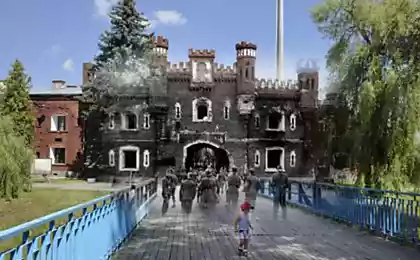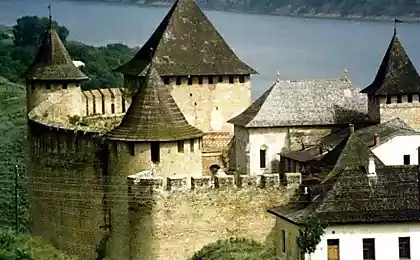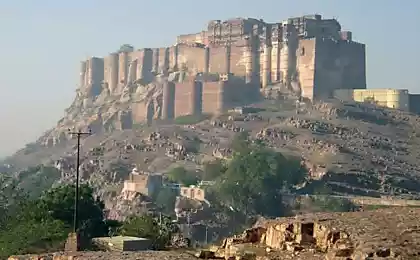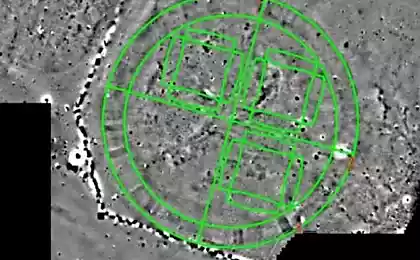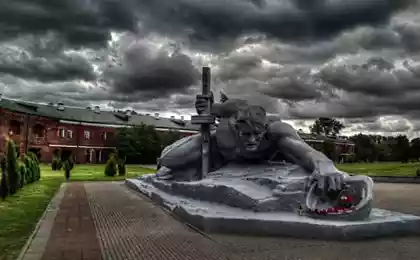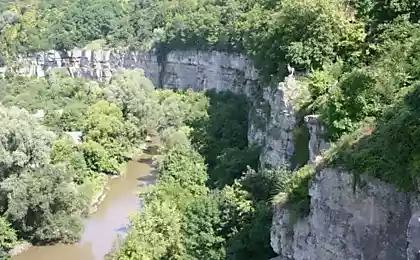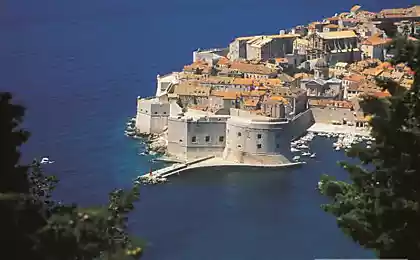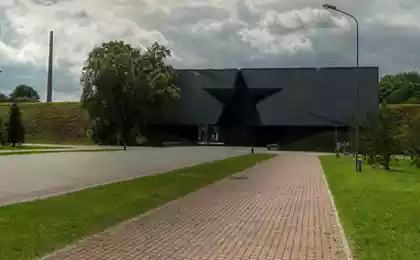918
Kamenetz-Podolsk fortress and not only
A big hello to all fans to travel!
Well, once again hit the road? At this time in the glorious city museum Kamenetz-Podolsk. Let's start with his business card - an ancient fortress.
Kamenetz-Podolsk fortress was first mentioned in 1374 in the charter of Prince George Koriatovichey who owned while the hem. Archaeological studies show that the castle existed in the X-XIII centuries. At first, it was a typical Old Russian wooden defensive structure. Walls and towers were mostly wood and partially stone. In the XV century. Skirts were captured Polish-gentry power, and Kamenetz-Podolsk was the center of the province, an important point of defense of the Commonwealth.
01 - General view of the fortress from the city
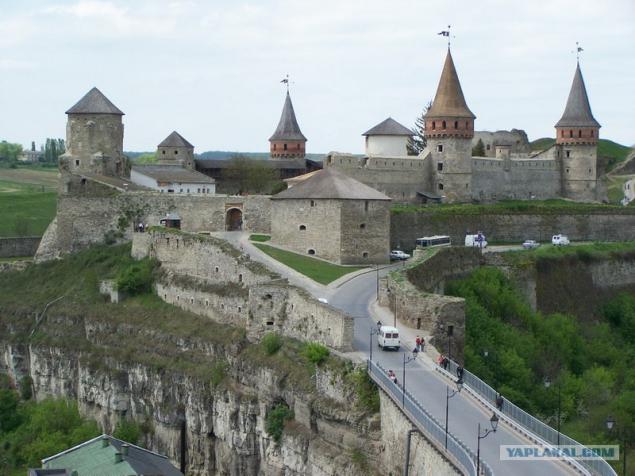
In the middle of the XVI century. wooden fortifications fortress under the supervision of Job Pretvicha were replaced with stone. Fortress is a polygon elongated, enclosed by high walls with towers at each corner. To the right of the east gate is a single-tier black pentagonal tower with a well depth of 36 m and a diameter of 6 meters. Then the circle is 10 towers - Lyantskoronskaya, Commandant, Rozhanka, water, new, dennaya, Lascaux, Tenchinskaya, hood and left of the east gate - Papal or Karmelyukova. This is the last name of the tower was in the XIX century. When it was planted Ustim Karmelyuk.
02 - The main gate to the fortress

In 1672, the city of Kamenetz-Podolsk, as well as all skirts, captured by the Turks. They restored the ruined fortifications, but no significant facilities in the complex of fortifications are not made. Due to the fact that there is a Turkish garrison, the castle and the bridge of the people began to call "Turkish».
03 - In this tower is a very deep well.

After joining in 1812 Bessarabia to the Russian Empire Turkish border moved, and Kamenetz-Podolsk fortress as a defensive structure has lost its value, it was used for accommodation of the garrison, and later - as a prison.
04 - A huge wheel, actuated by muscle power, raise and lower the water tank.

In 1928, the fortress as a reminder of antiquity, according to the decision of SNK of the USSR was declared republican reserve, and in 1937 organized here museum-reserve. In 1948 the castle entered in the State Register of historical and architectural monuments of national importance.
05 - Patio with guns

The castle is located outside the city, it is located at the only entrance to the city, which led to a narrow (9 m) isthmus. The original stone buildings of the castle were built in the twelfth and thirteenth centuries. In the fourteenth and fifteenth centuries. and the XVI century. he was repeatedly extended and rebuilt; its final stage emerged in the middle of the XVI century. In terms of irregular Castle (175h50 m), its nine towers are in the completion mashikuli with arcature on stone brackets. Under the tower Rozhanka mashikuli traces frieze, executed in the technique of black and red sgraffito. Severe steep cliffs serve as a natural pedestal for these walls and towers, different in terms of (round, square, pentagonal) and volumes. In the guise of the terrible majesty of the Castle united, nice and subtle harmony with the landscape. In architecture, it visibly embodied the characteristics of Podolsk school of architecture. On the decoration of the premises of the castle, found during excavations tiles with plant ornament or reliefs. Among them attract the attention of the image of mounted warriors, it is very popular in folk art. They decorated the doors, shutters, or residential furniture and chests. They reflected the warlike spirit of the era of persistent struggle against the Tatar-Turkish invaders. Reliefs molded in gray clay in the form of wood, which had, in the negative, carvings, which explains some of their angularity and sketch a shape, but at the same time they can not deny the great expressiveness.
06 - The inner space of the fortress
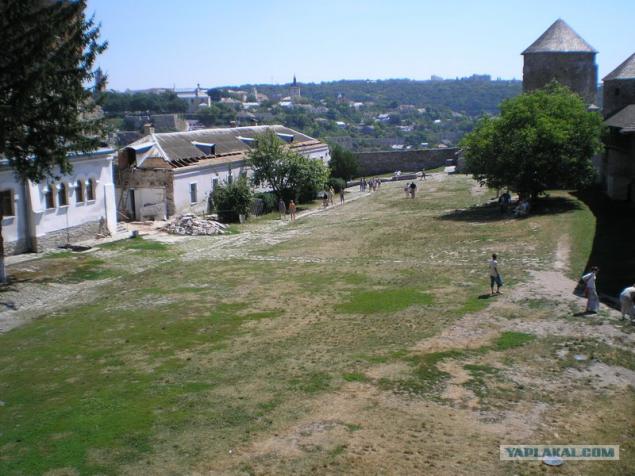
Since 1362 for 1434 years. fortress complex with fortifications of the city became the main Lithuanian outpost, and with 1434 for 1793. - Polish domination in Podil, played an important role in the reflection of the Turkish-Tatar aggression. In the fifteenth century. Podolia 28 times was attacked by Tatar hordes in the sixteenth century. - 18, the first half of the seventeenth century. - 5. The most devastating for the city and the fortress was the invasion of the Tatars in 1448, 1451, 1509, 1528, and the Turkish troops under the command of Abaza Pasha in 1833. All these attacks have been successfully reflected and created a reputation in Europe as a fortress impregnable stronghold. The fortress was in the middle of the action of the liberation war of the Ukrainian people. From 12 August to the end of November 1648 the fortress and the city under siege and storming troops repulsed the rebels and the local Cossack Colonel Maxim Krivonos. April 27 and May 2, 1651 launched a fierce assault on Kamenetz Cossacks on the leadership of Colonel Ivan Bohun. In August 1651 suddenly attacked and captured a little not Podolsk rebels under the command of Aleksandrenko and Chuikov. In early June 1652.g. the fortress and the city was besieged by 60 thousand army led by Hetman E.Hmelnitskim. The epidemic and famine broke out in the camp of the Cossacks did not allow them to exercise a decisive assault on the fortress. In the fall of 1653 under the walls Kamenetz was 40000th Tatar horde. At the same time during the war in the fortress were tortured and executed hundreds of fighters for freedom of Ukraine.
07 - Val and the remains of fortifications around the fortress

At the beginning of August 1672 to the city and the fortress approached 300,000th Turkish army led by Sultan Mohammed V and 40-thousand army of Tatars and Cossacks hetman Doroshenko. There was a fierce battle for two weeks. Meanwhile, the city went to the top of a conspiracy against the invaders and 18 August has handed them a city. In protest, the commandant of the fortress and Major Michal Volodyevsky Gekling blew up the powder magazine of the castle. Together with them were killed by the explosion of 800 people. defenders. In 27 years the Turks rebuilt the fortress became a bastion of the Ottoman yoke in Podolia. In 1699, under the terms of the armistice Karlovitskogo Kahriman Pasha returned the keys to the city and fortress of the Polish authorities. Returning from the Prut campaign and its fortress Kamenetz visited in 1711 Tsar Peter I.
08 - Another view of the courtyard of the fortress
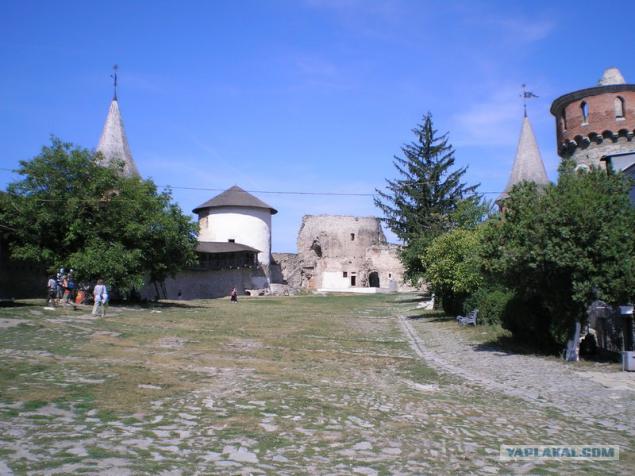
Since the beginning of the eighteenth century. Fortress is increasingly being used as a prison by the Polish government. B January 1703 after the torture was impaled Cossack Colonel Abaza, in 1748 the leader of the rebels executed Cleophas (Greek origin), martyred at the fortress hundreds Haidamaks. In 1734 here was taken into custody three years contender for the throne of Poland Stanislaw August. After forty years in the dungeons have been concluded and Peshinsky Frakenberg conspirators who tried to kill the King Stanislaw August. For abuse of authority was held prisoner in the fortress of the king's stepson A. Grabowski, later member of the Polish uprising in 1794 led by T.Kostyushko.
09 - One of the few restored towers
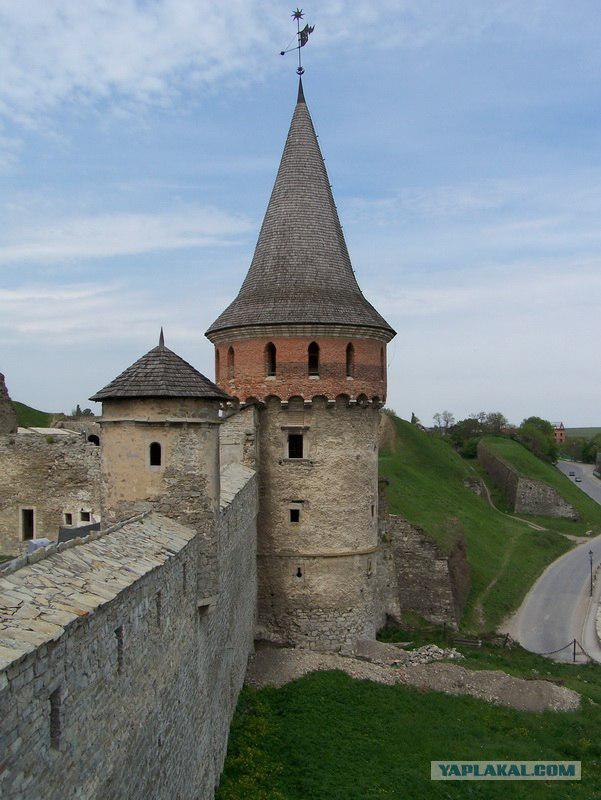
April 21, 1793 the city withdrew on the second section of the Commonwealth to the Russian. On this day, the commandant of the fortress presented on Pidzamche Russian command keys to the city and the castle and the cathedral took the oath of allegiance to Russia. In honor of this event fort saluted 101 artillery rounds.
10 - Tower name Karmelyuka the foreground in front of a lattice tower on the ground closed debt pit, where debtors were thrown, are not calculated in time with its creditors.

In connection with the Patriotic War of 1812 in the fortress were constantly Russian troops. Here in 1815 he served as an officer Konstantin Batyushkov (1787 - 1855) - the famous Russian poet and writer who their impressions about the history of the castle outlined in the essay "Memories from the field, fighting and travel." In 1846 the fortress served Rajewski (1795 - 1872), to organize a progressive-minded officers prodekabristsky circle "Iron rings».
11 - The reconstruction and restoration of the remaining towers of the fortress

From 1816 and 1914. Fortress ceased to be a military facility and turned into a prison for debtors, criminal and political prisoners. On the strength of activities related to the head of the anti-feudal movement Podoliya the first third of the XIX century. Karmalyuk folk hero William (1787 - 1835). Born in the village. Golovchintsy Litin County (today. Karmalyukovoe Zhmerinka in Vinnytsia region), the son of a serf. Gave his landlord for volnolyubiya soldiers in the 1812-1813 biennium. He served in Kamenetz. Having escaped from the royal army, Karmalyuk began an active struggle against the landlords. He was arrested in June 1814 brought to Kamenetz (probably kept in the fortress). The verdict was 500 beats shpitsrutenami. The second time serving his sentence in the Papal tower fortress in 1817-1818 gg., Which ended in the punishment of 25 strokes of the whip in the town square near the Town Hall, branding iron and exile in Siberia. In 1822 Karmalyuk again found himself in a prison cell Papal tower. In the night from 12 to 13 March 1823 he organized an escape from the fortress of the eleven prisoners who had been wounded and two weeks later the authorities caught and returned to the tower. B April 1823 on the square in the town hall punished 101 lashes and exiled to Siberia. In antiserfdom activity, which lasted until 1835, Karmalyuk involved about 20 thousand. Podolyan oppressed. Since then, the papal fortress tower people called Karmalyukovoy.
12 - On the wall of the gallery completely restored

In 1906, the fortress contained 67 political prisoners. Among them are well-known agent of social-democratic newspaper "Iskra", one of the leaders of Kamenetz-Podolsk group RSDLP NG Kozitskii (1880 - 1920). Along with him were colleagues in the chamber VK Cherniavsky, SA Ilnitsky and others.
Decree of People's Commissars of the Ukrainian SSR on March 23, 1923 the castle was declared a historical and cultural reserve. It is currently housed at the Soviet and pre-revolutionary divisions Historical Museum-Reserve. Each year, the fortress is visited by an average of 300 thousand. Tourists and sightseers
13 - Pass in one of the walls

In the late 30-ies of XX century. wall Karmalyukovoy (Papal) tower was made with a shallow rectangular niche inserted plate of white stone with an inscription. 04/18/1958 over this niche of a memorial plaque with barelєfom Karmalyuk and dedicatory text (author JM Ambitsky) Inside the tower is framed exposition devoted to activities Ustym Karmalyuk. To the right of the entrance gate to the castle is a marble plaque (0, 0 7 x 5 mm) with the portrait of VF Rajewski with dedicatory inscriptions.
14 - View from one of the towers of the driveway
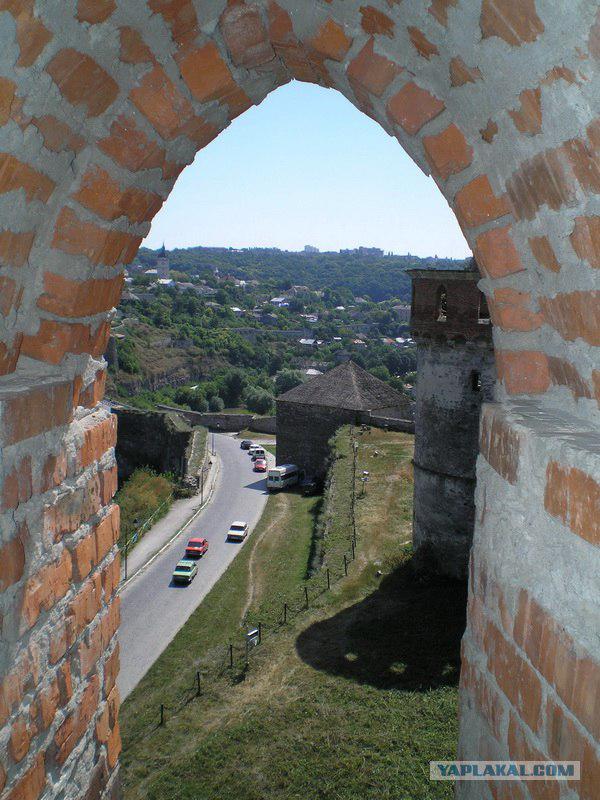
Kamenetz-Podolsk old fortress and now protects secrets gradually revealed by researchers.
15 - heavily damaged part of the fortress where in addition to the restoration of archeological work

A few years ago, geologists Kamenetz-Podolsk Industrial Technical conducted at the fortress drilling. On the roadway from Pidzamche they found quicksand. Last year, he destroyed the retaining wall and made a dirt road in the direction of the fluid stream Smotrych. I formed a sufficiently large pit. Opened foundation walls of the fortress depth of more than 5 meters. They lie on the limestone rock jutting into a canyon along the river.
Clearing and excavations have shown that stone retaining walls and extends to the west of the Old Fortress bastions to the new one. The excavation revealed the foundation cushion supports the old bridge, which were later covered with earth. From the south, there is a hole in the wall width of 2, 5 and 5 meters high, through which probably was passed water.
16 - View of the towers of the fortress

Thus, under the ground revealed structures that are a continuation of the surface of the walls of the fortress and was buried under the bulk soil bridge to the gate, the remains of which are preserved in the pit. This makes it possible to draw such conclusions. Territory fortifications occupies all the capes of the peninsula, has walls and towers, built on a rocky foundation, and then covered with earth. Eleven towers communicate with each other moves, walking the defensive wall. These moves are built on the rocks, then covered and then.
17 - Gallery on one of the walls

So, throughout its existence, from the XII century castle, being old Russian defense structure, rebuilt from wood into stone in the middle of the XIII century, the XV-th and in the middle of the XVI century. At the beginning of the XVII century constructed bastions. The last reconstruction at the end of the XVIII century the fortress gave a modern look.
18 - View of the bridge that connects the castle with the city

19 - View of the tower and a gift shop Karmelyuka
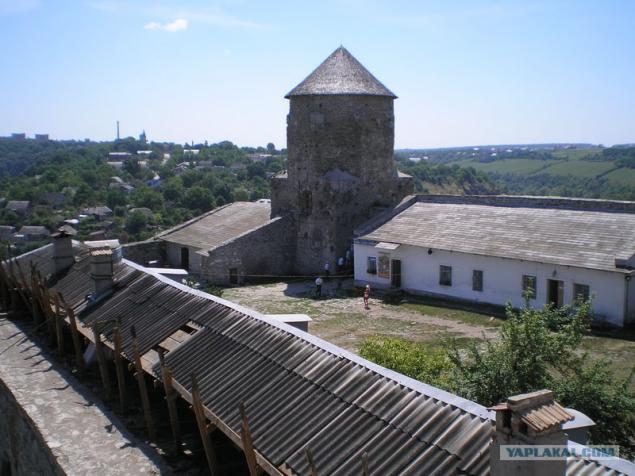
20 - Another shot of the towers of the species with lighting fixtures in a corner from the right. At night, the fortress is well illuminated.

21 - The view from the fortress of the canyon, the suspension bridge on the left and an old wooden church, assembled without nails, right.

22 - The majestic land bridge. According to one legend, his creation is somehow involved in Romans

23 - The entrance to the bridge from the castle

24 - City Gate, a favorite place for wedding photos of local residents.

Next we'll go to the cathedral church of the city, it will be interesting
Cathedral of St. Peter and Paul can rightly be called a second hallmark after the famous "flower in stone" as dubbed mighty fortress Kamenetz-Podolsk Lesya Ukrainka. The uniqueness of the church lies in the combination of architecture of two different religions - Christianity and Islam.
25 - Entrance to the church of St. Peter and Paul

Various architectural styles of different historical epochs successfully intertwined in this major Peter and Paul Cathedral. But the surprise is not only the beauty of the gate design, a symbiosis of architectural styles of the temple, but ... a real minaret, which still greater miracle - a sculpture of Our Lady.
26 - Bright element of Gothic Revival. Side of the church
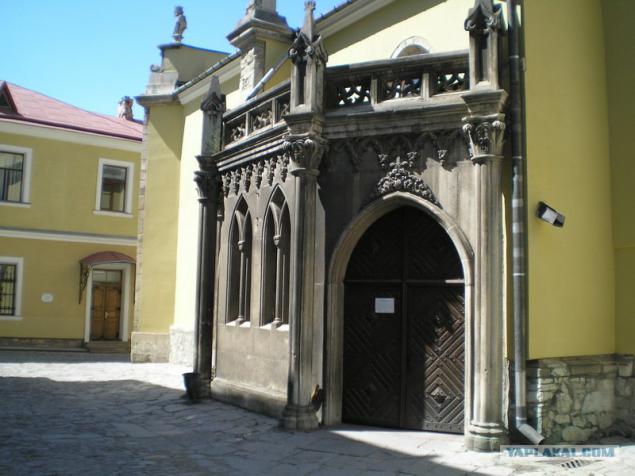
Date of establishment of the Kamenetz cathedral is not known. From the descriptions of the church I know that it was built in 1375 of wood during the first bishop of the Kamenetz, Dominican Wilhelm. Stone is credited with the construction of the church bishop Jacob Buceatchi (1502-1517). In the middle of the XVI century, Bishop Leonard Slonczewski (1547-1562) attaches Chapel of the Blessed Virgin Mary Immaculate, and comfort. In the period of Turkish rule (1672-1699) the cathedral church was the main Muslim mosque Kamenetz-Podolsk (possibly Eyalet). To this she added a minaret 36, 5 m, with 145 stone steps. After returning to the Poles on the minaret was a statue of the Virgin (in 1756), a height of 3, 5 m. The Virgin stands on a globe and crescent, blessing the city and region. Around her head a halo of 12 stars.
27 - The facade of the church
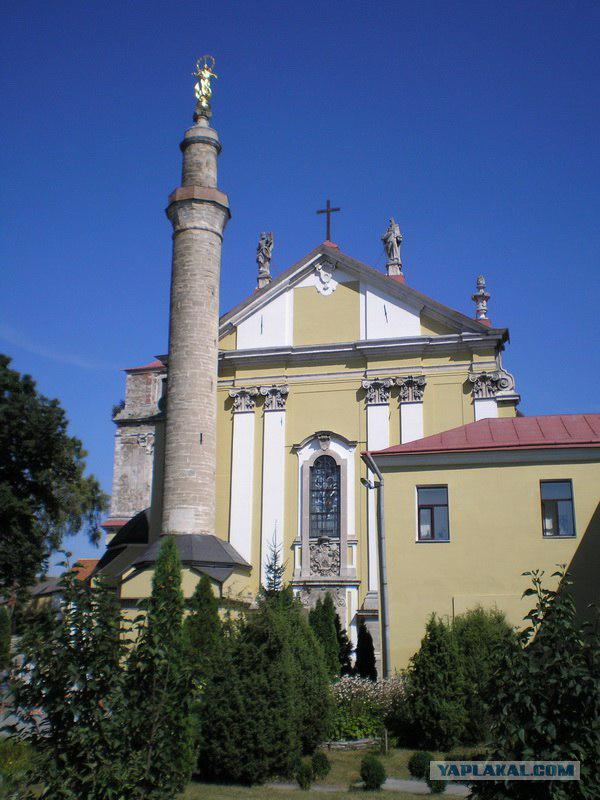
In memory about the establishment of the Madonna, in the lower part of the minaret was the inscription "Mother of God Immaculate Lady Patroness of the city." In 1820, lightning struck the statue went straight down through the minaret, and there was a fire. Three years later, as a result of Hurricane statue she bent that it was the fear of falling and the threat of congregational life. Therefore, for some time because of that the service was transferred to the Dominican church. It is worth noting that in many guidebooks and Statt indicates that the bronze statue, that is not true. In the middle of the last century it was carried out the restoration, in which it was found that the bronze sculpture of the Virgin Mary - "... from the hollow bell copper»
28 - Close-up of the statue on the minaret

Cathedral of Peter and Paul is famous not only an amazing mix of two different religious cultures, but also the charming sound body. Kamenetz-Podolsk organ was installed in the middle of the XIX century. During the overhaul. Made it by the Austrian Karl Hesse, has two manual keyboards, a pedal and 20 registers 972trubi. New life after World War II, he was given the Estonian masters, they changed the tube, add keys and registers, set motor. If you go to a concert of organ music in the church, consider that you are very lucky, because this type of body in all only in Ukraine, but in Europe there are only seven of his colleagues.
29 - View of the authority

The chapel is Advisors amazing work of art that will make you stop and marvel at the realism of such a strong image. The author of the tombstone of a young 21-year-old Laura Pshezdetskoy is a famous sculptor Victor Brodzky. Volynyanin by birth, a student of the famous Vitali, to create a truly a masterpiece of beauty to comfort parents that ohoronyayut angels. Brodzkogo works are all over the world - in Switzerland and in Poland, a large part is in the Hermitage Museum and the Vatican.
30 - The famous sculpture of Laura
Dobavleno1 in [mergetime] 1263082685 [/ mergetime]
Source:
Well, once again hit the road? At this time in the glorious city museum Kamenetz-Podolsk. Let's start with his business card - an ancient fortress.
Kamenetz-Podolsk fortress was first mentioned in 1374 in the charter of Prince George Koriatovichey who owned while the hem. Archaeological studies show that the castle existed in the X-XIII centuries. At first, it was a typical Old Russian wooden defensive structure. Walls and towers were mostly wood and partially stone. In the XV century. Skirts were captured Polish-gentry power, and Kamenetz-Podolsk was the center of the province, an important point of defense of the Commonwealth.
01 - General view of the fortress from the city

In the middle of the XVI century. wooden fortifications fortress under the supervision of Job Pretvicha were replaced with stone. Fortress is a polygon elongated, enclosed by high walls with towers at each corner. To the right of the east gate is a single-tier black pentagonal tower with a well depth of 36 m and a diameter of 6 meters. Then the circle is 10 towers - Lyantskoronskaya, Commandant, Rozhanka, water, new, dennaya, Lascaux, Tenchinskaya, hood and left of the east gate - Papal or Karmelyukova. This is the last name of the tower was in the XIX century. When it was planted Ustim Karmelyuk.
02 - The main gate to the fortress

In 1672, the city of Kamenetz-Podolsk, as well as all skirts, captured by the Turks. They restored the ruined fortifications, but no significant facilities in the complex of fortifications are not made. Due to the fact that there is a Turkish garrison, the castle and the bridge of the people began to call "Turkish».
03 - In this tower is a very deep well.

After joining in 1812 Bessarabia to the Russian Empire Turkish border moved, and Kamenetz-Podolsk fortress as a defensive structure has lost its value, it was used for accommodation of the garrison, and later - as a prison.
04 - A huge wheel, actuated by muscle power, raise and lower the water tank.

In 1928, the fortress as a reminder of antiquity, according to the decision of SNK of the USSR was declared republican reserve, and in 1937 organized here museum-reserve. In 1948 the castle entered in the State Register of historical and architectural monuments of national importance.
05 - Patio with guns

The castle is located outside the city, it is located at the only entrance to the city, which led to a narrow (9 m) isthmus. The original stone buildings of the castle were built in the twelfth and thirteenth centuries. In the fourteenth and fifteenth centuries. and the XVI century. he was repeatedly extended and rebuilt; its final stage emerged in the middle of the XVI century. In terms of irregular Castle (175h50 m), its nine towers are in the completion mashikuli with arcature on stone brackets. Under the tower Rozhanka mashikuli traces frieze, executed in the technique of black and red sgraffito. Severe steep cliffs serve as a natural pedestal for these walls and towers, different in terms of (round, square, pentagonal) and volumes. In the guise of the terrible majesty of the Castle united, nice and subtle harmony with the landscape. In architecture, it visibly embodied the characteristics of Podolsk school of architecture. On the decoration of the premises of the castle, found during excavations tiles with plant ornament or reliefs. Among them attract the attention of the image of mounted warriors, it is very popular in folk art. They decorated the doors, shutters, or residential furniture and chests. They reflected the warlike spirit of the era of persistent struggle against the Tatar-Turkish invaders. Reliefs molded in gray clay in the form of wood, which had, in the negative, carvings, which explains some of their angularity and sketch a shape, but at the same time they can not deny the great expressiveness.
06 - The inner space of the fortress

Since 1362 for 1434 years. fortress complex with fortifications of the city became the main Lithuanian outpost, and with 1434 for 1793. - Polish domination in Podil, played an important role in the reflection of the Turkish-Tatar aggression. In the fifteenth century. Podolia 28 times was attacked by Tatar hordes in the sixteenth century. - 18, the first half of the seventeenth century. - 5. The most devastating for the city and the fortress was the invasion of the Tatars in 1448, 1451, 1509, 1528, and the Turkish troops under the command of Abaza Pasha in 1833. All these attacks have been successfully reflected and created a reputation in Europe as a fortress impregnable stronghold. The fortress was in the middle of the action of the liberation war of the Ukrainian people. From 12 August to the end of November 1648 the fortress and the city under siege and storming troops repulsed the rebels and the local Cossack Colonel Maxim Krivonos. April 27 and May 2, 1651 launched a fierce assault on Kamenetz Cossacks on the leadership of Colonel Ivan Bohun. In August 1651 suddenly attacked and captured a little not Podolsk rebels under the command of Aleksandrenko and Chuikov. In early June 1652.g. the fortress and the city was besieged by 60 thousand army led by Hetman E.Hmelnitskim. The epidemic and famine broke out in the camp of the Cossacks did not allow them to exercise a decisive assault on the fortress. In the fall of 1653 under the walls Kamenetz was 40000th Tatar horde. At the same time during the war in the fortress were tortured and executed hundreds of fighters for freedom of Ukraine.
07 - Val and the remains of fortifications around the fortress

At the beginning of August 1672 to the city and the fortress approached 300,000th Turkish army led by Sultan Mohammed V and 40-thousand army of Tatars and Cossacks hetman Doroshenko. There was a fierce battle for two weeks. Meanwhile, the city went to the top of a conspiracy against the invaders and 18 August has handed them a city. In protest, the commandant of the fortress and Major Michal Volodyevsky Gekling blew up the powder magazine of the castle. Together with them were killed by the explosion of 800 people. defenders. In 27 years the Turks rebuilt the fortress became a bastion of the Ottoman yoke in Podolia. In 1699, under the terms of the armistice Karlovitskogo Kahriman Pasha returned the keys to the city and fortress of the Polish authorities. Returning from the Prut campaign and its fortress Kamenetz visited in 1711 Tsar Peter I.
08 - Another view of the courtyard of the fortress

Since the beginning of the eighteenth century. Fortress is increasingly being used as a prison by the Polish government. B January 1703 after the torture was impaled Cossack Colonel Abaza, in 1748 the leader of the rebels executed Cleophas (Greek origin), martyred at the fortress hundreds Haidamaks. In 1734 here was taken into custody three years contender for the throne of Poland Stanislaw August. After forty years in the dungeons have been concluded and Peshinsky Frakenberg conspirators who tried to kill the King Stanislaw August. For abuse of authority was held prisoner in the fortress of the king's stepson A. Grabowski, later member of the Polish uprising in 1794 led by T.Kostyushko.
09 - One of the few restored towers

April 21, 1793 the city withdrew on the second section of the Commonwealth to the Russian. On this day, the commandant of the fortress presented on Pidzamche Russian command keys to the city and the castle and the cathedral took the oath of allegiance to Russia. In honor of this event fort saluted 101 artillery rounds.
10 - Tower name Karmelyuka the foreground in front of a lattice tower on the ground closed debt pit, where debtors were thrown, are not calculated in time with its creditors.

In connection with the Patriotic War of 1812 in the fortress were constantly Russian troops. Here in 1815 he served as an officer Konstantin Batyushkov (1787 - 1855) - the famous Russian poet and writer who their impressions about the history of the castle outlined in the essay "Memories from the field, fighting and travel." In 1846 the fortress served Rajewski (1795 - 1872), to organize a progressive-minded officers prodekabristsky circle "Iron rings».
11 - The reconstruction and restoration of the remaining towers of the fortress

From 1816 and 1914. Fortress ceased to be a military facility and turned into a prison for debtors, criminal and political prisoners. On the strength of activities related to the head of the anti-feudal movement Podoliya the first third of the XIX century. Karmalyuk folk hero William (1787 - 1835). Born in the village. Golovchintsy Litin County (today. Karmalyukovoe Zhmerinka in Vinnytsia region), the son of a serf. Gave his landlord for volnolyubiya soldiers in the 1812-1813 biennium. He served in Kamenetz. Having escaped from the royal army, Karmalyuk began an active struggle against the landlords. He was arrested in June 1814 brought to Kamenetz (probably kept in the fortress). The verdict was 500 beats shpitsrutenami. The second time serving his sentence in the Papal tower fortress in 1817-1818 gg., Which ended in the punishment of 25 strokes of the whip in the town square near the Town Hall, branding iron and exile in Siberia. In 1822 Karmalyuk again found himself in a prison cell Papal tower. In the night from 12 to 13 March 1823 he organized an escape from the fortress of the eleven prisoners who had been wounded and two weeks later the authorities caught and returned to the tower. B April 1823 on the square in the town hall punished 101 lashes and exiled to Siberia. In antiserfdom activity, which lasted until 1835, Karmalyuk involved about 20 thousand. Podolyan oppressed. Since then, the papal fortress tower people called Karmalyukovoy.
12 - On the wall of the gallery completely restored

In 1906, the fortress contained 67 political prisoners. Among them are well-known agent of social-democratic newspaper "Iskra", one of the leaders of Kamenetz-Podolsk group RSDLP NG Kozitskii (1880 - 1920). Along with him were colleagues in the chamber VK Cherniavsky, SA Ilnitsky and others.
Decree of People's Commissars of the Ukrainian SSR on March 23, 1923 the castle was declared a historical and cultural reserve. It is currently housed at the Soviet and pre-revolutionary divisions Historical Museum-Reserve. Each year, the fortress is visited by an average of 300 thousand. Tourists and sightseers
13 - Pass in one of the walls

In the late 30-ies of XX century. wall Karmalyukovoy (Papal) tower was made with a shallow rectangular niche inserted plate of white stone with an inscription. 04/18/1958 over this niche of a memorial plaque with barelєfom Karmalyuk and dedicatory text (author JM Ambitsky) Inside the tower is framed exposition devoted to activities Ustym Karmalyuk. To the right of the entrance gate to the castle is a marble plaque (0, 0 7 x 5 mm) with the portrait of VF Rajewski with dedicatory inscriptions.
14 - View from one of the towers of the driveway

Kamenetz-Podolsk old fortress and now protects secrets gradually revealed by researchers.
15 - heavily damaged part of the fortress where in addition to the restoration of archeological work

A few years ago, geologists Kamenetz-Podolsk Industrial Technical conducted at the fortress drilling. On the roadway from Pidzamche they found quicksand. Last year, he destroyed the retaining wall and made a dirt road in the direction of the fluid stream Smotrych. I formed a sufficiently large pit. Opened foundation walls of the fortress depth of more than 5 meters. They lie on the limestone rock jutting into a canyon along the river.
Clearing and excavations have shown that stone retaining walls and extends to the west of the Old Fortress bastions to the new one. The excavation revealed the foundation cushion supports the old bridge, which were later covered with earth. From the south, there is a hole in the wall width of 2, 5 and 5 meters high, through which probably was passed water.
16 - View of the towers of the fortress

Thus, under the ground revealed structures that are a continuation of the surface of the walls of the fortress and was buried under the bulk soil bridge to the gate, the remains of which are preserved in the pit. This makes it possible to draw such conclusions. Territory fortifications occupies all the capes of the peninsula, has walls and towers, built on a rocky foundation, and then covered with earth. Eleven towers communicate with each other moves, walking the defensive wall. These moves are built on the rocks, then covered and then.
17 - Gallery on one of the walls

So, throughout its existence, from the XII century castle, being old Russian defense structure, rebuilt from wood into stone in the middle of the XIII century, the XV-th and in the middle of the XVI century. At the beginning of the XVII century constructed bastions. The last reconstruction at the end of the XVIII century the fortress gave a modern look.
18 - View of the bridge that connects the castle with the city

19 - View of the tower and a gift shop Karmelyuka

20 - Another shot of the towers of the species with lighting fixtures in a corner from the right. At night, the fortress is well illuminated.

21 - The view from the fortress of the canyon, the suspension bridge on the left and an old wooden church, assembled without nails, right.

22 - The majestic land bridge. According to one legend, his creation is somehow involved in Romans

23 - The entrance to the bridge from the castle

24 - City Gate, a favorite place for wedding photos of local residents.

Next we'll go to the cathedral church of the city, it will be interesting
Cathedral of St. Peter and Paul can rightly be called a second hallmark after the famous "flower in stone" as dubbed mighty fortress Kamenetz-Podolsk Lesya Ukrainka. The uniqueness of the church lies in the combination of architecture of two different religions - Christianity and Islam.
25 - Entrance to the church of St. Peter and Paul

Various architectural styles of different historical epochs successfully intertwined in this major Peter and Paul Cathedral. But the surprise is not only the beauty of the gate design, a symbiosis of architectural styles of the temple, but ... a real minaret, which still greater miracle - a sculpture of Our Lady.
26 - Bright element of Gothic Revival. Side of the church

Date of establishment of the Kamenetz cathedral is not known. From the descriptions of the church I know that it was built in 1375 of wood during the first bishop of the Kamenetz, Dominican Wilhelm. Stone is credited with the construction of the church bishop Jacob Buceatchi (1502-1517). In the middle of the XVI century, Bishop Leonard Slonczewski (1547-1562) attaches Chapel of the Blessed Virgin Mary Immaculate, and comfort. In the period of Turkish rule (1672-1699) the cathedral church was the main Muslim mosque Kamenetz-Podolsk (possibly Eyalet). To this she added a minaret 36, 5 m, with 145 stone steps. After returning to the Poles on the minaret was a statue of the Virgin (in 1756), a height of 3, 5 m. The Virgin stands on a globe and crescent, blessing the city and region. Around her head a halo of 12 stars.
27 - The facade of the church

In memory about the establishment of the Madonna, in the lower part of the minaret was the inscription "Mother of God Immaculate Lady Patroness of the city." In 1820, lightning struck the statue went straight down through the minaret, and there was a fire. Three years later, as a result of Hurricane statue she bent that it was the fear of falling and the threat of congregational life. Therefore, for some time because of that the service was transferred to the Dominican church. It is worth noting that in many guidebooks and Statt indicates that the bronze statue, that is not true. In the middle of the last century it was carried out the restoration, in which it was found that the bronze sculpture of the Virgin Mary - "... from the hollow bell copper»
28 - Close-up of the statue on the minaret

Cathedral of Peter and Paul is famous not only an amazing mix of two different religious cultures, but also the charming sound body. Kamenetz-Podolsk organ was installed in the middle of the XIX century. During the overhaul. Made it by the Austrian Karl Hesse, has two manual keyboards, a pedal and 20 registers 972trubi. New life after World War II, he was given the Estonian masters, they changed the tube, add keys and registers, set motor. If you go to a concert of organ music in the church, consider that you are very lucky, because this type of body in all only in Ukraine, but in Europe there are only seven of his colleagues.
29 - View of the authority

The chapel is Advisors amazing work of art that will make you stop and marvel at the realism of such a strong image. The author of the tombstone of a young 21-year-old Laura Pshezdetskoy is a famous sculptor Victor Brodzky. Volynyanin by birth, a student of the famous Vitali, to create a truly a masterpiece of beauty to comfort parents that ohoronyayut angels. Brodzkogo works are all over the world - in Switzerland and in Poland, a large part is in the Hermitage Museum and the Vatican.
30 - The famous sculpture of Laura
Dobavleno1 in [mergetime] 1263082685 [/ mergetime]
Source:


